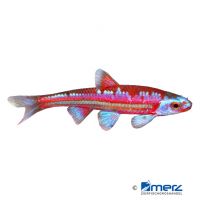Rainbow Shiner (Notropis chrosomus)
| Rainbow Shiner Notropis chrosomus | |
|---|---|
| Name | Rainbow Shiner |
| Name Lat. | Notropis chrosomus |
| Family | Minnows |
| Family lat. | Leuciscidae |
| Order | Carps |
| Order lat. | Cypriniformes |
| Origin | North America |
| Habitat | Streams, rivers |
| Diet | Omnivore |
| pH | 6.5-7.5 |
| Behavior | Peaceful |
| Keeping | Swarm |
| Care Level | Moderate |
| Reproduction | Egg scatterer |
| Breeding | Moderately difficult |
| Life Span | 3-5 years |
| Protection | No |
| Metric Units | |
| Size | 5-8 cm |
| Temperature | 6-26 °C |
| Hardness | 5-20 °dH |
| Aquarium | ~ 150 l or ponds |
| US Units | |
| Size | 2"-3" |
| Temperature | 43-79 °F |
| Hardness | 89-356 ppm |
| Aquarium | ~ 40 gal or ponds |
Distribution and habitat
The range of the rainbow minnow is the southern United States, extending from Alabama and Georgia to northwestern Tennessee. There they live in the shallow water of streams and small rivers with sand and gravel near the shore, where they often stay in shoals near the water surface.
Maintenance
The pond should be furnished with pond, floating and especially oxygenating underwater plants (milfoil, waterweed, hornwort, etc.), large river pebbles, and a substrate of sand and round-grained gravel, and provide plenty of free swimming space.
When maintaining in a cold water aquarium, make sure there is plenty of swimming space in addition to perimeter planting and plenty of hiding places (roots, rocks). A sandy substrate and oxygen-rich water with some current is ideal
No ammonia, ammonium and nitrite may be detectable in the water, the nitrate value may not exceed 100 mg/l. To ensure the water quality and oxygen content, a filter adapted to the water volume should not be missing.
Diet
They feed mainly on insects, small crustaceans and worms as well as approach food (mosquitoes) taken from the water surface. The food supply consists of live or frozen cyclops, daphnia, tubifex and mosquito larvae or a frozen food mixture. High quality pond food (granules, pellets, flakes) is also often accepted after habituation
Behaviour and compatibility
They are lively schooling fish that do not exhibit any aggressive or incompatible behaviors. At least 10, but preferably more Rainbow Minnows should be kept together. They can be socialized well with other fish, such as gudgeons (Gobio gobio).
In principle, only mutually compatible fish species with similar requirements for water conditions and water temperature should be socialized.
Reproduction and breeding
The head and fins of males are colored a bright neon blue, while those of females are bright red. In the spawning season, males and females turn blood red.
The spawning season is from May to June. They are free spawners, spawning in shallow water over gravel-covered bottom. Eggs remain attached to rocks, larvae hatch after 3-5 days and swim free after another 4-7 days.
Important
The rainbow minnow is not a native species and therefore special care must be taken to prevent it from entering the wild (fauna adulteration!).
It also tolerates water temperatures up to 28 °C well
If they are overwintered in the pond, sufficient depth and oxygen supply (filter, oxygen dispenser, ice free holder) must be ensured
At temperatures below 8-10 °C the metabolism of the fish slows down and food is no longer accepted, feeding must be stopped accordingly. If the temperature drops further, they hibernate near the bottom. In spring, with rising temperatures, feeding can slowly be resumed. Feeding may also be necessary during prolonged warm periods in winter.
The well-being of the fish should be monitored regularly. A regular partial water change, according to the pond size is recommended, even if the pollutant load has not yet reached the upper limit. Sudden changes in water quality should be avoided. Newly introduced fish must be accustomed slowly to the water in the pond or aquarium
Further literature can be found in your pet store.
References
Text: Werner Winter; Image: Zierfischgroßhandel Merz
Source: BMELV (1998): Tierschutzgutachten - Haltung von Zierfischen (Süßwasser); ENGELMANN (2005): Zootierhaltung - Tiere in menschlicher Obhut: Fische; Harri Deutsch Verlag
- Gemäß § 21 Abs. 5 Tierschutzgesetz idgF
